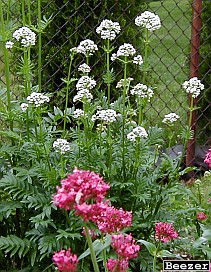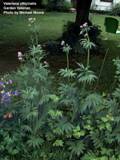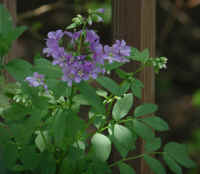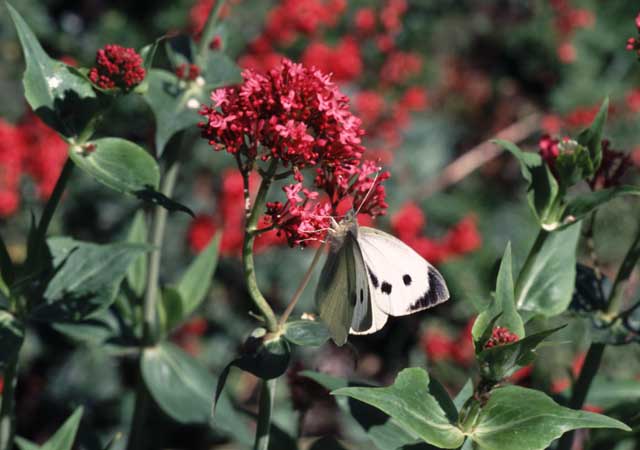Plant Study
Common Name [Valerian]
Family Name: English
Family Name: Latin
Latin Name: Valeriana Officinalis
Common Names: Garden valerian
Native American Names:
Related Species:
Body System Affiliations:
1. Nervous System
2. Digestive System
Botanical Description (web site)
Habit: Herb Perennial
Size: 3 to 4 feet tall
Arrangement: Opposite
Leaves: Each leaf is made up of a series of lance-shaped segments, more or less
opposite to one another on each side of the leaf (pinnate). The leaflets vary in
number, from six to ten pairs as a rule, and vary in breadth, being broad when few
in number and narrower when more numerous; they are usually 2 to 3 inches long
Flowers: Small, tinged with pink and flesh color, with a peculiar, but not exactly
unpleasant smell. The corolla is tubular, and from the midst of its lobes rise the stamens,
only three in number, though there are five lobes to the corolla. The limb of the calyx is
remarkable for being at first enrolled and afterwards expanding in the form of a feathery
pappus, which aids the dissemination of the fruit
Fruit: A capsule containing one oblong compressed seed
Bark:
Twigs: Only one stem arises from the root, which attains a height of 3 or 4 feet. It is
round, grooved and hollow, more or less hairy, especially near the base
Underground Parts: rhizomatous
Ecology:
Habitat: It prefers damp swampy areas but can be found in the higher, dry elevations
Range: The plant is found throughout Europe and Northern Asia, and is common in England in marshy thickets and on the borders of ditches and rivers
Native Where: North America and England
Ecological Relationships:
Places/Dates Observed/Description:
Western (European-American) Uses/Relationships:
Food: It was well known to the Anglo-Saxons, who used it as a salad. Materials/Technology. In the Middle Ages, the root was used not only as a medicine but also as a spice, and even as a perfume. It was the custom to lay the roots among clothes as a perfume (vide Turner, Herbal, 1568, Pt. III, p. 56)
(web site)
Medicine: Valerian is a powerful nerve stimulant, carminative and antispasmodic. Used as a sedative to the higher nerve centers in conditions of nervous unrest, hypochondrias, neuralgic pains and the like. The drug allays pain and promotes sleep. It is of especial use and benefit to those suffering from nervous overstrain, as it possesses none of the after-effects produced by narcotics. (web site)
Part Used: roots (THD pg. 574) leaves and flowers (web site)
Medicinal Actions: Valerian is a powerful nerve stimulant,
carminative and antispasmodic. Used as a sedative to the higher nerve
centers in conditions of nervous unrest, hypochondrias, neuralgic pains
and the like. The drug allays pain and promotes sleep. It is of especial use
and benefit to those suffering from nervous overstrain, as it possesses none
of the after-effects produced by narcotics. (web site)
Indications: Remember those terms we’ve been discussing in class
Body System Associations: Nervous System and Digestive System
Constituents: The chief constituent of Valerian is a yellowish-green to brownish-yellow oil, which is present in the dried root to the extent of 0.5 to 2 per cent though an average yield rarely exceeds 0.8 per cent. The oil is contained in the sub-epidermal layer of cells in the root, not in isolated cells or glands. It is of complex composition, containing valerianic, formic and acetic acids, the alcohol known as borneol, and pinene. The valerianic acid present in the oil is not the normal acid, but isovalerianic acid, an oily liquid to which the characteristically unpleasant odor of Valerian is due. It is gradually liberated during the process of drying, being yielded by the decomposition of the chief constituent, bornyl-isovalerianate, by the ferment present. It is strongly acid, burning to the palate and with the odor of the plant. The oil is soluble in 30 parts of water and readily in alcohol and ether. (web site)
Applications: Decoction, tincture, teas, extracts and poultice (web site and THD pg 574)
Preparation:
- Decoction/teas; boil the Valerian root with liquorish, aniseed,
and raisons
- Tincture; A mixture of Valerian, Nutmeg oil, Lemon oil with a distilled water
Pharmacy: Typical dosage: 300 to 400 milligrams standardized to 0.5 percent essential oil in capsules per day (one hour before bedtime if using as a sleep aid); or 1/8 to 3 teaspoons of tincture up to every two hours, this for anxiety. (THD page 89)
Typical dosage for cardiac arrhythmias: 50 to 100 milligrams of standardized extract containing 0.8 percent valeric acid two or three times a day; or 20 to 60 drops of tincture per day. (THD page 152)
Typical dosage for chronic fatigue syndrome: one cup of tea(simmer 2 teaspoons of dried, minced roots in 2 cups water for 10 to 15 minutes with other herbs to hide the taste; or ½ to 1 tsp of tincture in water.(THD page 170)
Cautions: Though rare, minor side effects-including headaches,
excitability, and insomnia- may occur with continual use.
REPEAT ABOVE AS NECESSARY FOR VARIOUS PLANT PARTS
Indigenous and Non-Western Use/Significance/Relationships: If available, write “None found” if you don’t find any. CITE ALL SOURCES IF YOU DO FIND.
Food: none found
Materials/Technology: none found
Medicine:
Indigenous Group: none found
Part Used:
Medicinal Actions: none found
Indications: none found.
Energetics:. none found
Harvest: none found
Storage: none found
Preparation: none found
Applications: none found
Pharmacy: none found
Cautions: none found
***
REPEAT ABOVE AS NECESSARY FOR VARIOUS GROUPS
AND/OR PLANT PARTS.
OMIT CATEGORY TITLES FOR WHICH THERE IS NO
INFORMATION OR WRITE “NONE FOUND.”
Other: If any.
Propagation:
Technique:
Timing:
Harvest:
Plant Part: Flower tops must be cut off as they appear, thus enabling the
better development of the rhizome
Season of Harvest: September or early October, all the tops are cut off with a scythe
and the rhizomes are harvested
Method of Harvest: cut
Ecological Considerations of Harvest:
Cultural Considerations of Harvest:
Cautions:
Repeat for various parts of the plant..
Personal Experience:
Food: none
Materials/Technology:
Medicine:
Part Used: Root
Desired Medicinal Actions: calm nerves
Targeted Indications: anxiety, depression, plus aid in sleep
Harvest: If plant was not harvested, see Procurement below
Site Location:
Site Description:
(Ownership, Soil, Light Conditions, Topography, Other
Plant Species Present, Quantity/Condition of Desired Species, Evidence of Animal Activity, Evidence of Human Activity, Reason for Selection)
Technique
Processing
Storage
Experience
Procurement:
Source Radiance
Condition Dried
Cost
Other Procurement Information “None found”
Application/Preparation/Pharmacy:
Applications: Tea
Preparation: Crushed the dried root then added it to my tea blend
Pharmacy: Drank tea until finished over the period of one day
Reason/Purpose: Help with the depression brought on by sever
pain
Experience: It brought some relief to the depression and helped a
little with the pain, working with what medications the doctor
prescribed
Cautions based on experience:
Other: If any; omit if none
Other Notes of Interest: Such as Cultural Information if any found; omit if none
Cautions: STATE THEM AGAIN EVEN THOUGH YOU SAID THEM ALREADY

Drawings, Photographs or Pressings [on separate pages]: 
(NOTE: ONE ORIGINAL DRAWING IS REQUIRED)
http://billybeezer.com/garden/plants/valerian.html
http://www.swsbm.com/Images/New8-21/Valeriana_officinalis.jpg

http://www.all-creatures.org/picb/wfshl-greekvalerian.html
http://valerian.ourmed.org.uk/
http://www.butterflygarden.co.uk/plants/kentranthus.htm
References Cited:
- Linda B. White, M.D., Steven Foster and the staff of Herbs for Health The Herbal Drugstore Rodale inc. @ 2000
- http://www.101-vitamins-minerals supplements.com/valerian_root_supplements_information.htm
- http://valerian.ourmed.org.uk/
- Earthway by Mary Summer Rain
Kid Friendly Book on Valerian
Children’s version of plant study
I am Valerian! I have conquered Europe and Northern Asia, but I am also common in England, found in marshy thickets and on the borders of ditches and rivers, where my tall stems can generally be seen in the summer towering above the usual herbage. I stand erect, I have rich, dark green leaves, they are beautifully formed, and the crowning masses of light-colored flowers make me conspicuous.

I have a camphoraceous, slightly bitter taste and have a very powerful, disagreeable odor, which gradually develops during the process of drying me. I owe the change which occurs in the composition of a volatile oil contained in my sub-epidermal layer of cells: the odor of my fresh root, though not very agreeable, is devoid of the unpleasant valerianaceous odor.
My whole genus family is comprised of about 150 species, which are widely distributed in the temperate parts of the world. Meet some of my cousins Japanese and Mexican, say hello to them



I have an effect on the nervous system of many animals, especially cats, which seem to be thrown into a kind of intoxication by my scent. It is scarcely possible to keep me in a garden after my leaves or root have been bruised or disturbed in any way, for cats are at once attracted and roll on me. It is equally attractive to rats and is often used by rat-catchers to bait their traps. It has been suggested that the famous Pied Piper of Hamlin owed his irresistible power over rats to the fact that he secreted my roots about his person. 
Name- Mylee Ring
Program –Art, Environment, and the Child
Quarter-Winter
Year-06

